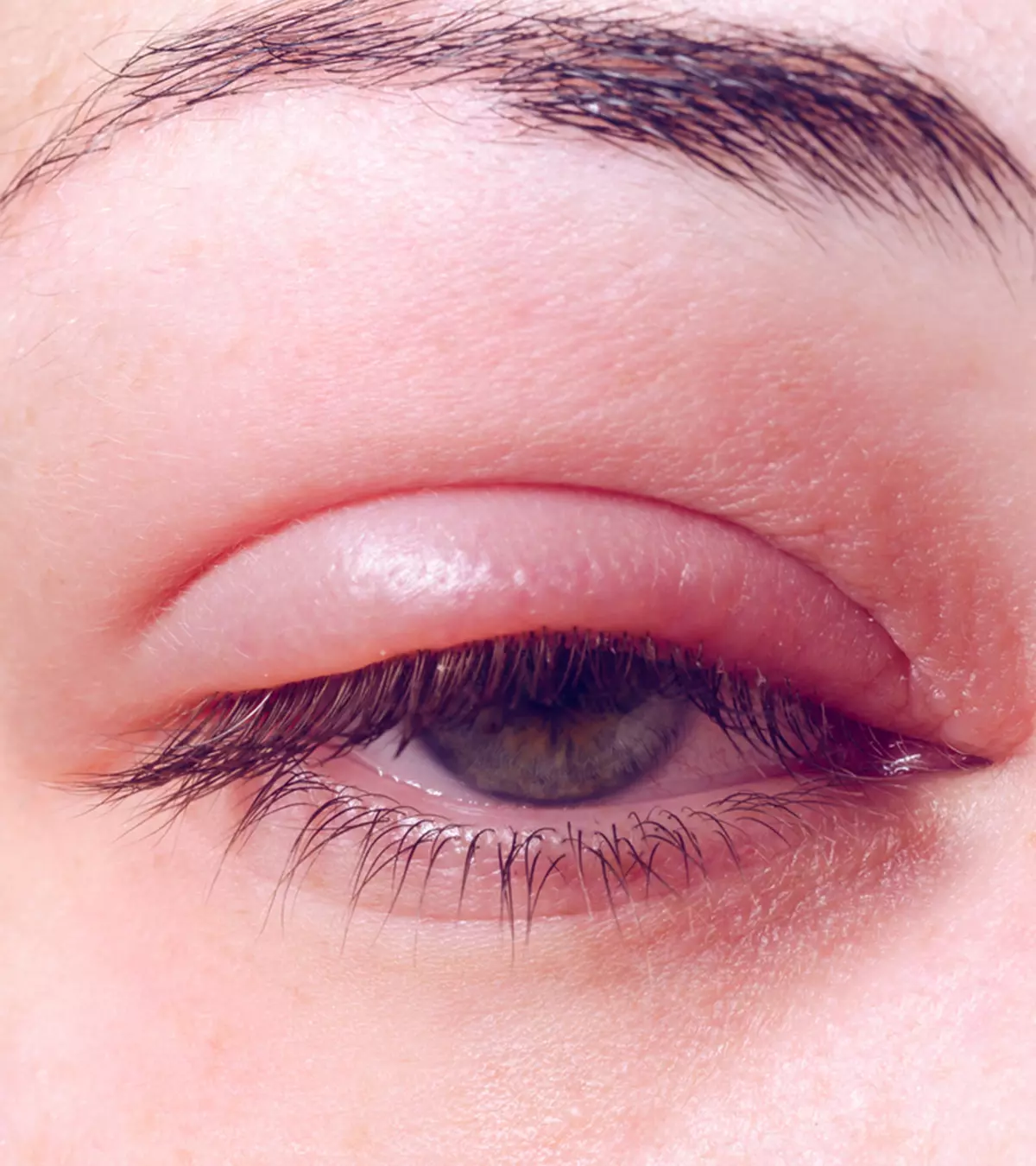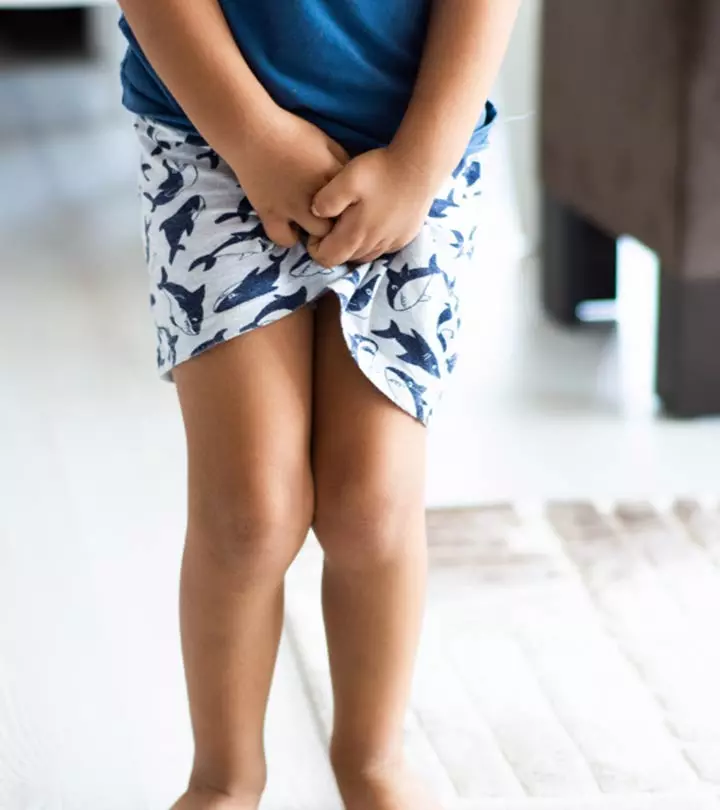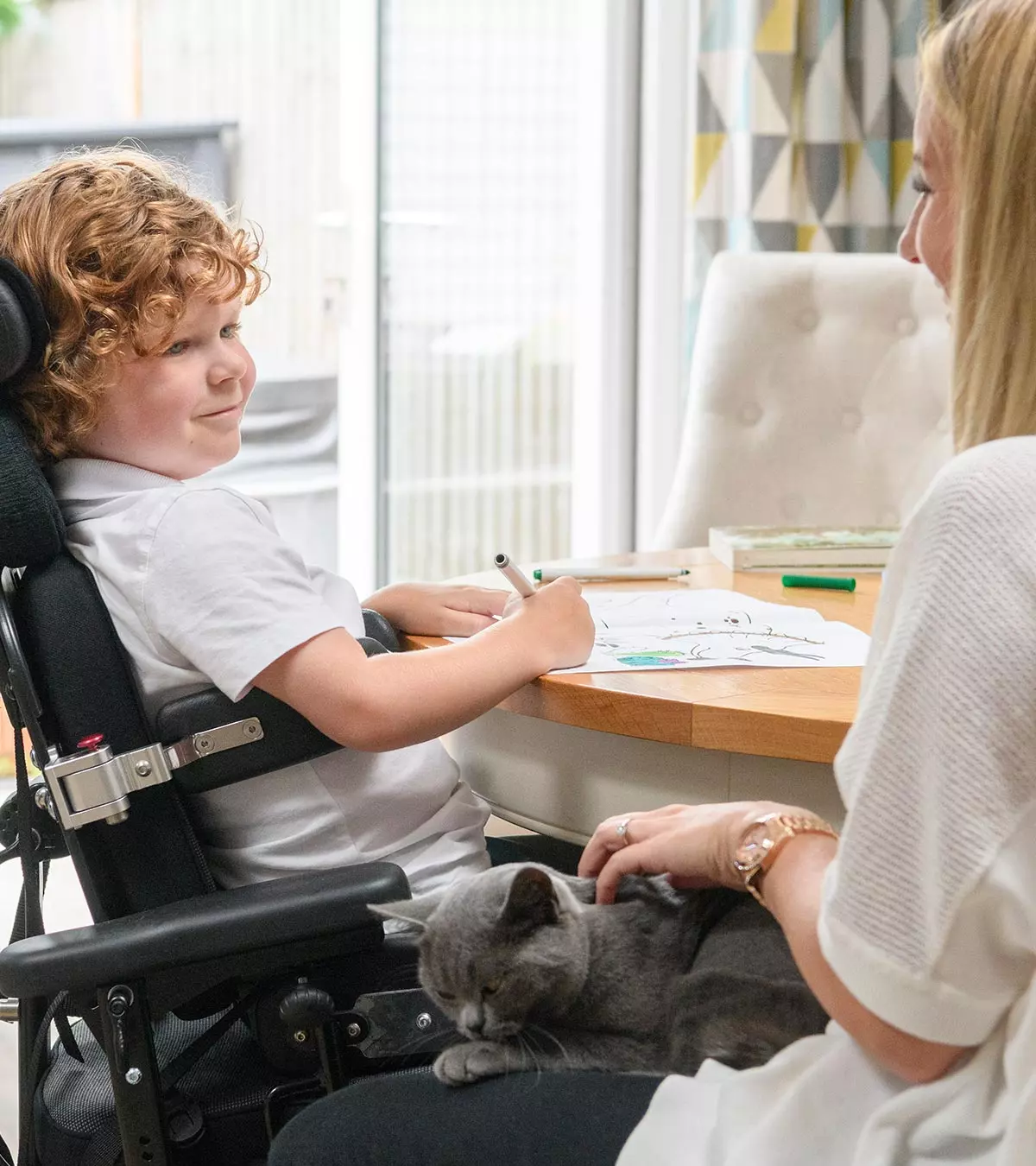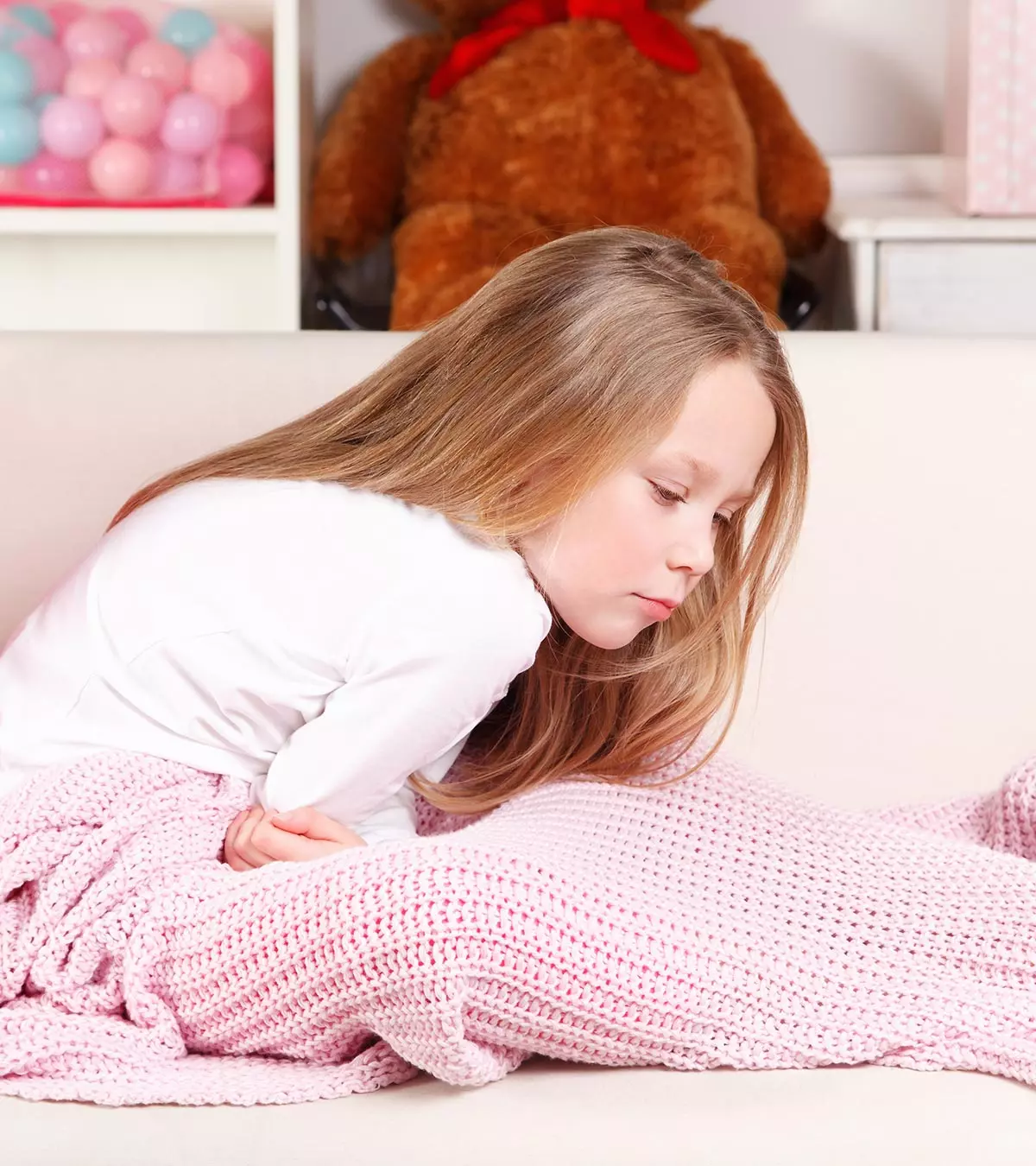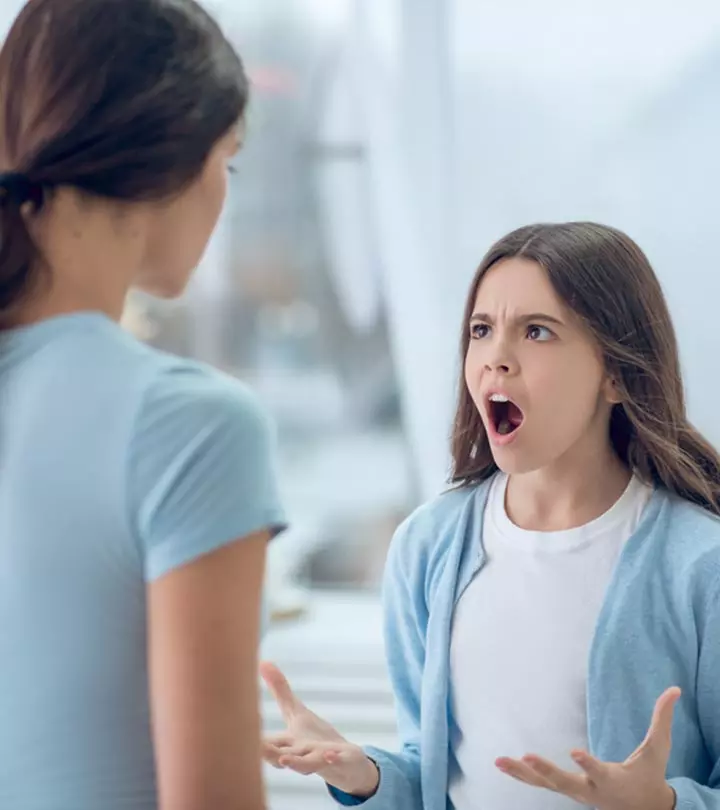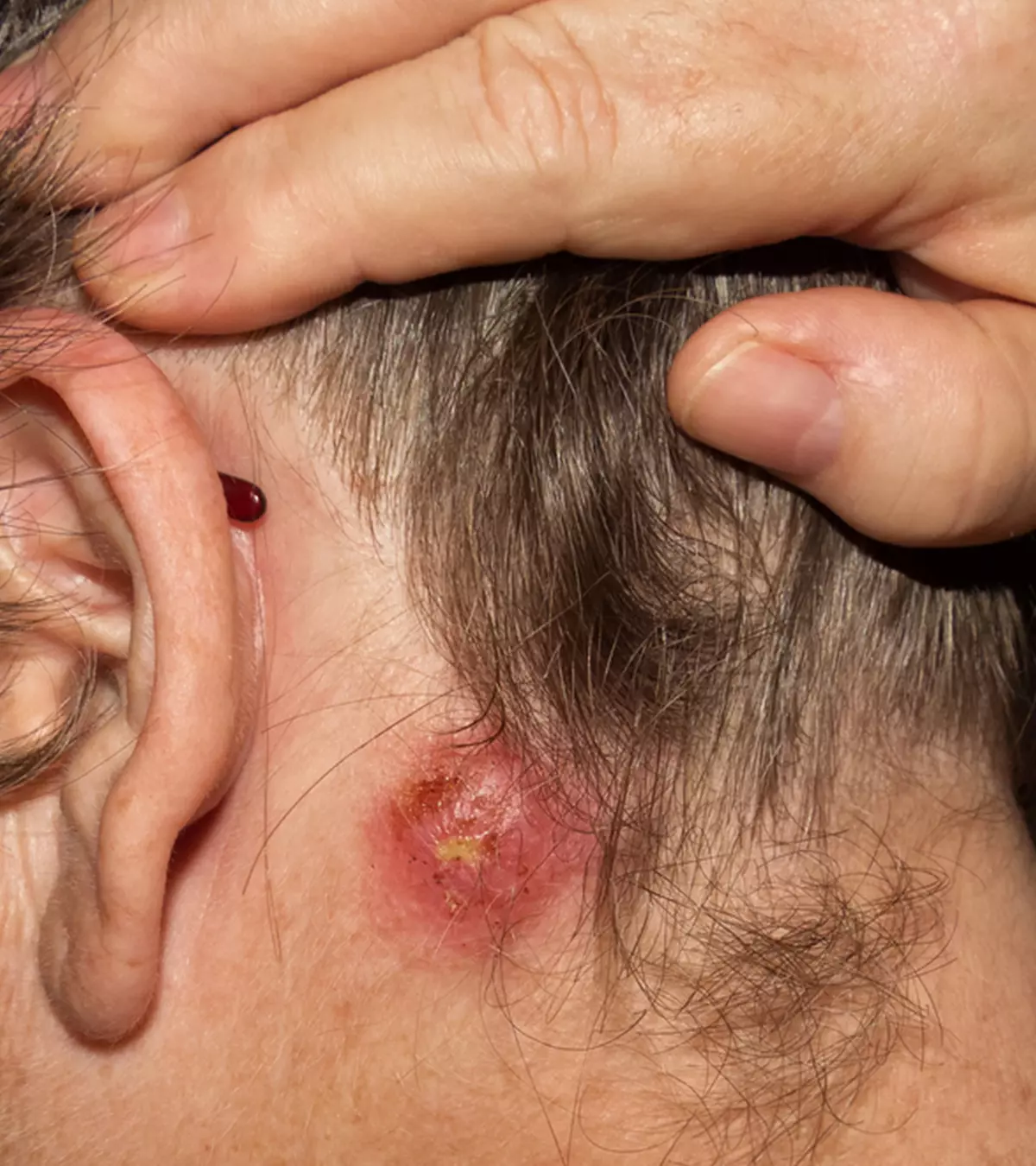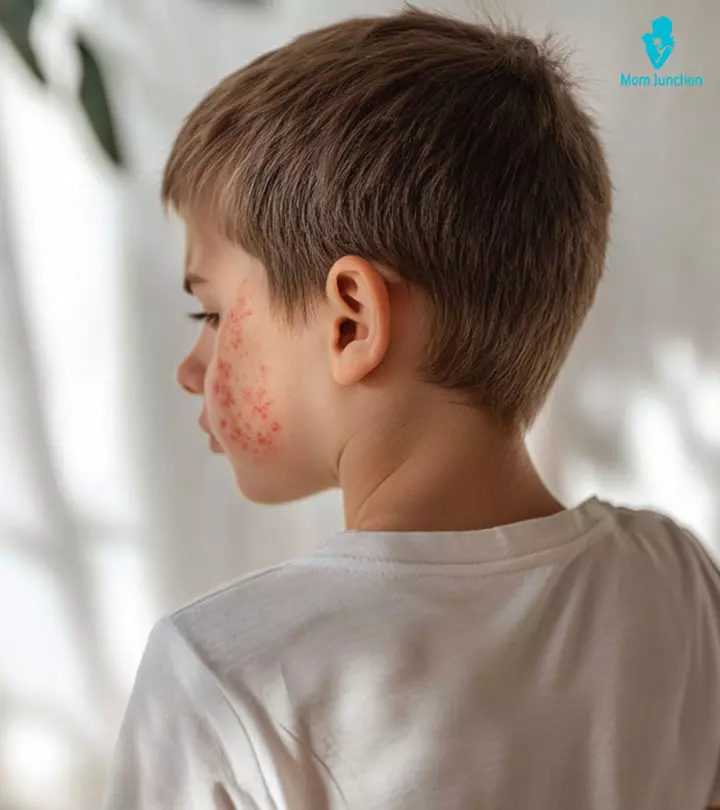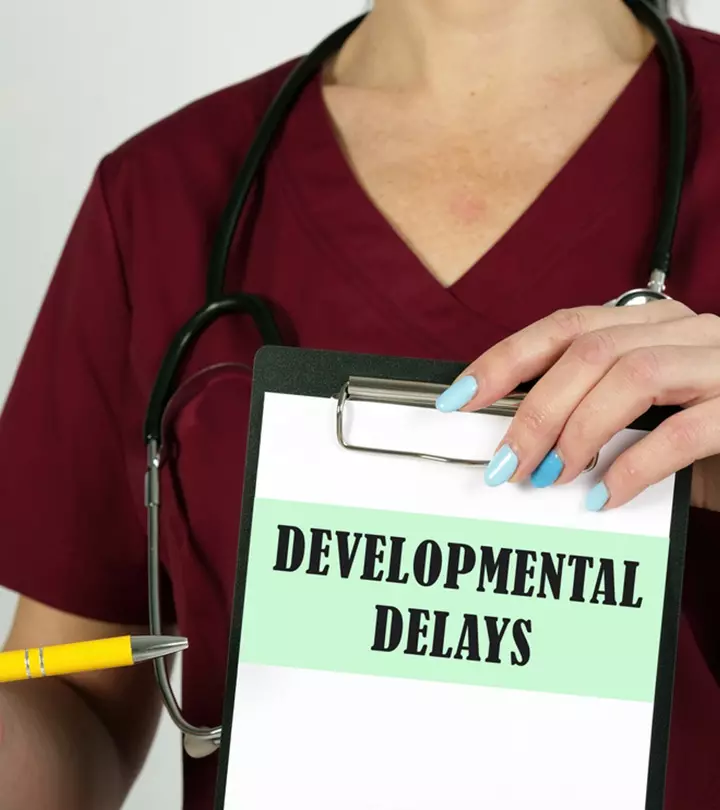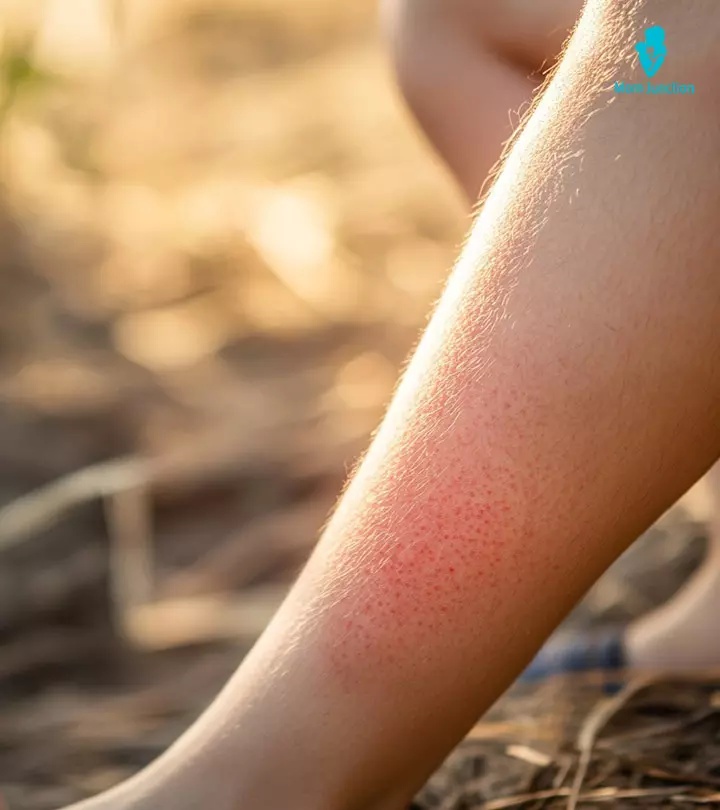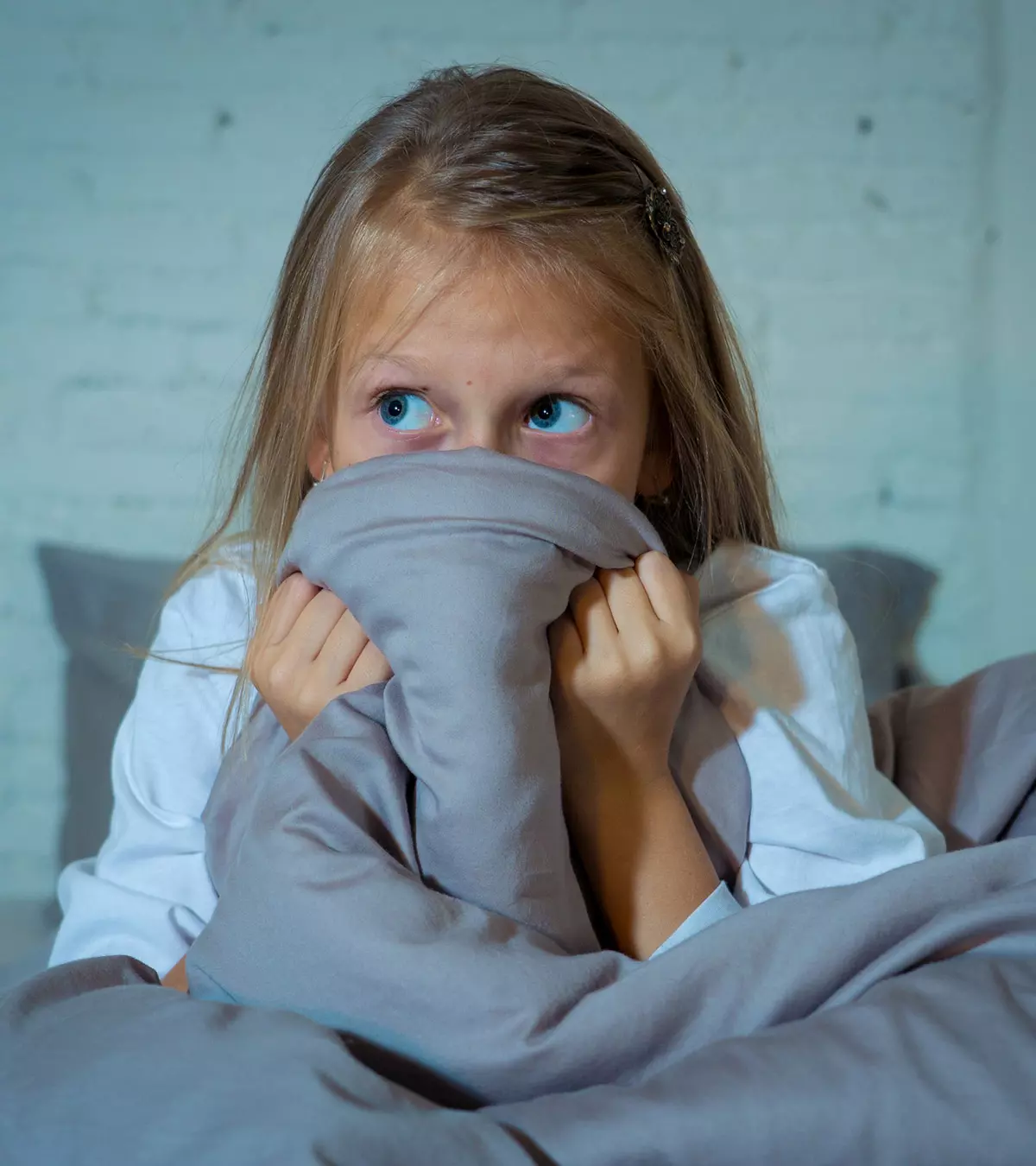
Shutterstock
Lymph nodes are kidney-shaped organs in the neck, under the jaw (submandibular lymph nodes), under the chin (sublingual lymph nodes), underarms or armpit (axillary lymph nodes), groin, chest, and abdomen. They are a part of the immune system and play an important role in filtering the blood and killing bacteria and viruses. Swollen lymph nodes or lymphadenopathy is common in childhood and may occur due to bacterial or viral infections, such as colds, flu, or strep throat infectioniA bacterial infection brought on by group A Streptococcus bacteria that cause throat irritation and inflammation (1).

Read this post to learn about the causes, symptoms, complications, diagnosis, and treatment of swollen lymph nodes in children.
Key Pointers
- Bacterial and viral throat infections, respiratory infections, tooth decay, ear infections, and various autoimmune conditions can cause swollen lymph nodes in children.
- Symptoms such as pain, feeling of lumps in the throat, and redness may indicate swollen lymph nodes.
- Homecare measures such as warm or cold compresses and getting medications for underlying conditions help to improve swollen lymph nodes in children.
Causes Of Swollen Lymph Nodes In Children

Pediatrician Dr. Raashid Hamid says, “Lymphadenopathy (swollen lymph nodes) is classified into two main types: generalized and regional. Generalized lymphadenopathy, often caused by systemic diseases, affects multiple lymph node areas. Regional lymphadenopathy, on the other hand, affects lymph nodes in a specific area and is commonly caused by local infections, such as viral or bacterial throat infections. It can also indicate malignancy, particularly when the nodes are firm and fixed.”
The following are the common causes of lymphadenopathy in kids (2) (3) (4) (5):
- Respiratory infections
- Viral throat infections
- Bacterial throat infections, such as strep
- Viral infections in children, such as flu, mononucleosisiAlso known as kissing disease, it is a contagious infection usually associated with the Epstein-Barr virus , and chickenpoxiA highly contagious viral infection that causes itchy and blister-like rashes due to the varicella-zoster virus
- Tooth decay or abscess
- AbrasionsiCuts and scrapes on the skin that happen due to contact against a rough surface , burns, or insect bites
- Scalp infections
- Skin infections, such as eczemaiA condition that causes itchy, inflamed, and dry skin and impetigo in children
- Mouth sores
- Ear infections
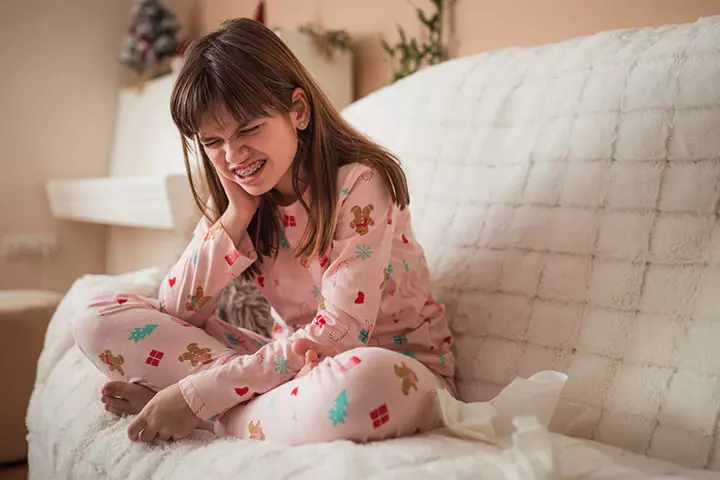
- Fungal infections
- Autoimmune conditions
- Some cancers, such as Hodgkin’s lymphomaiA type of cancer that affects the lymphatic system (a part of the immune system)
- Juvenile arthritisiOccurrence of persistent, chronic arthritis in children and some other joint conditions
Swollen lymph nodes that appear suddenly and are painful are usually caused by an injury. Certain medications, such as typhoid immunization and seizure drugs, such as phenytoin, can also cause swollen lymph nodes in children (6).
 Quick fact
Quick factInfographic: What Causes Swelling Of Each Lymph Node In Children?
Some thing wrong with infographic shortcode. please verify shortcode syntaxFrequency And Severity Of Swollen Lymph Nodes In Children
Every child may get lymphadenopathy at some point in their life (7). A recent study suggests that about 90% of children aged four to eight years may suffer from lymphadenopathy. Most of them are benign.
According to the American Academy of Pediatrics (AAP), a pea or bean-sized (i.e., smaller than ½ inch or 12 mm) swelling is considered normal (8). However, if the lymph nodes are getting bigger, it can be a sign of infection, and the process is called lymphadenitis. It can further be subdivided into:
- Acute lymphadenitis if the enlarged lymph nodes last for about two weeks
- Subacute lymphadenitis if it is there for more than 2 weeks
- Chronic lymphadenitis if it persists for more than 6 weeks (9).
South Africa-based pediatrician Dr. Elna Gibson advises, “As a general rule, if enlarged glands persist for more than 2 weeks, increase in size, or are accompanied by other symptoms, they should be evaluated by your child’s doctor.”
Symptoms Of Swollen Lymph Nodes In Children
The most common symptoms of swollen lymph nodes are (1)
- Lumps in the affected lymph node areas, commonly the sides or back of the neck (also known as cervical lymph nodes)
- Pain, tenderness, or soreness in the affected area
- Redness or warmth in the affected area
- Lymph nodes may be swollen several centimeters.
Depending on the underlying pathology, the following symptoms may also be seen (6):

- Fever and chills
- Respiratory issues, such as sore throat, nasal congestion, and cough
- Decreased appetite
- Body pain
- Headache
- Fatigue
- Weight loss
- Rash
- Night sweats in children
 Quick fact
Quick factSigns You Need To See A Doctor
Brooklyn-based board-certified pediatrician Dr. Edward Kulich says, “If swelling is accompanied by pain and fever, you should contact your healthcare provider immediately. Also, if the lymph nodes are swollen just above the collarbone, feel hard and rubbery, and are accompanied by chills, night sweats, and weight loss, it’s important to have them evaluated. Lastly, if they don’t go away after 4–6 weeks, they may need further evaluation.”
Monitor the persistent symptoms, and if the child develops new symptoms or complications, consult your healthcare professional for further evaluation. Contact your healthcare provider if you notice the following symptoms (1) (10):
- The child develops a fever (higher than 104° F) or a seizure accompanying it
- Painful swollen lymph nodes
- Lymph nodes that continue to grow or remain the same size beyond two weeks
- A large lymph node that is firm to touch
- Abnormal breathing sounds or the child complains of inability to breathe comfortably
Complications Of Swollen Lymph Nodes In Children
Swollen lymph nodes are the body’s natural response to infections and some diseases. However, ignoring the condition may delay the treatment of a serious underlying disease or infection (1).
While swollen lymph nodes signify a problem and are not a problem themselves, the following complications may rarely occur (3).
- May remain swollen or firm long after the infection has cleared up
- May hamper the other functions of the body
- Might break open and ooze pus
Child specialist Dr. Mubina Agboatwalla says, “Enlarged lymph glands that are rubbery or matted together may indicate a chronic disease like tuberculosis. Lymphomas, a type of malignancy, can also cause multiple enlarged lymph glands throughout the body. Enlarged lymph glands lasting more than a month are a cause for concern. It’s always best to consult a doctor.”
Diagnosing Swollen Lymph Nodes In Children
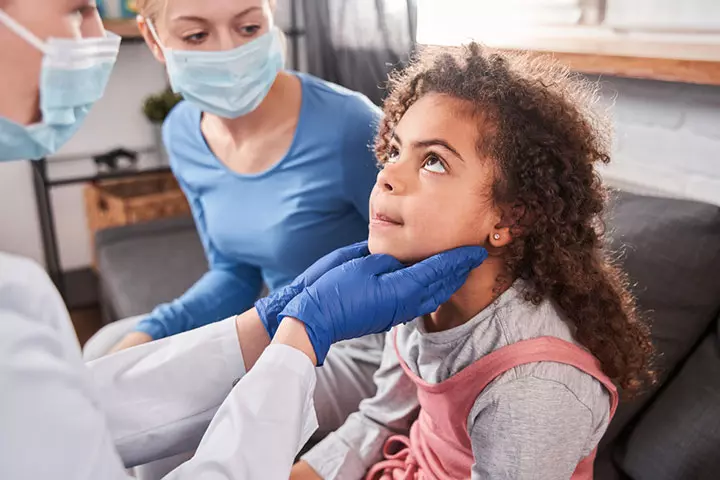
The diagnosis of swollen lymph nodes begins with a physical examination of the enlarged lymph nodes’ size and location. Further, the doctor will ask the following (1) (3) (11):
- A detailed medical history of the child
- For how many days the child has been exhibiting these symptoms
- Whether the child has been around children with strep throat
- Whether the child has consumed any unusual food or beverages, especially unpasteurized dairy products
- Whether the child has been around a young cat as a cat’s scratch can cause a mild condition called cat scratch disease characterized by enlarged lymph nodes.
After examining these details, the doctor might refer the child to a specialist and prescribe some of these diagnostic tests:
- Lab tests: A complete blood count (CBC) might be performed to check the red and white blood cells and platelets. Urine tests and tests to rule out tuberculosisiA disease caused by a potentially severe bacterial infection that affects the lungs might be performed.
- Imaging tests: These include chest X-rays, CT scans, or MRIs to check for enlarged lymph nodes or other underlying conditions.
- Lymph node biopsy: A surgeon may perform a biopsy to test the samples of the enlarged lymph nodes for different causes of enlargement. The child may be further referred to hematologists and oncologists.
 Quick fact
Quick factTreatment For Swollen Lymph Nodes In Children
In most cases, no intervention is needed for swollen lymph nodes. When required, the treatment depends on the underlying cause. It can be done at home for mild cases, while some children may need medications to manage it. Rarely, surgical intervention may be needed (3) (11).
1. Homecare
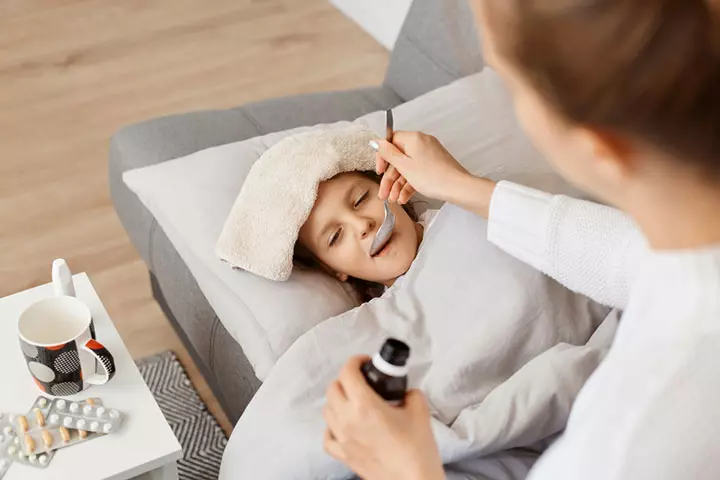
- Ensure plenty of rest, ample hydration, and good nutrition.
- Use cold or warm compresses to relieve pain in the tender region.
- Consider using natural remedies such as herbal teas with soothing properties or warm decaf tea with honey and lemon to help reduce inflammation.
- Give safe pain relief medications, such as acetaminophen, under the doctor’s advice. Remember, children under 19 years should not take Aspirin unless advised by a doctor, as it might put the child at risk of Reye syndrome. Also, Aspirin must be avoided if your child is recovering from chickenpox or flu-like symptoms (11).
- Instruct your child to not squeeze the lymph nodes (8).
2. Medications
- The child might need antibiotics for swelling caused by bacterial infections or anti-tuberculosis medicines for tuberculosis.
- The doctor might prescribe further medication based on the underlying condition.
- If the swollen lymph nodes are caused by cancer, the doctor may decide the treatment plan depending on the type and severity of the cancer. The treatment includes home care, medicines, surgery, radiation, and chemotherapy (11).
3. Surgery
- When required, surgical intervention might be suggested to remove the swollen lymph node.
- A pediatric surgeon might suggest incision and drainage for the swollen lymph nodes, depending on the cause.
- While surgery is generally safe, it might have some side effects, including blood clots, slow healing of wounds, risk of infection, and tingling sensation in the area of surgery (12).
Frequently Asked Questions
1. What is a concerning size for lymph nodes in children?
For children, lymph nodes of 1cm in the axilla, 2cm in the neck, and 1.5cm in the inguinal region are considered normal and do not need further investigations. However, lymph nodes that are 3cms or larger may be a cause for concern (13).
2. Is it normal to feel children’s lymph nodes in their necks?
Feeling some small, palpable lumps under your child’s skin is not unusual (14).
3. For how long can lymph nodes stay swollen in a child?
Lymph glands or nodes remain swollen as long as the infection is active. It begins to return to normal size over a few weeks (15).
4. What do cancerous lymph nodes feel like?
Enlarged cancerous lymph nodes may feel like small, movable lumps under the skin (16). Lymph nodes larger than 3cms are usually associated with malignancy (13).
5. Can a swollen lymph node be harmless?
Lymph nodes may remain swollen for a few weeks after you have been cured of the illness. In most cases, they shrink to the original size on their own. However, if they do not do so in two weeks, seek medical attention (17).
Swollen lymph nodes in children indicate an underlying issue and can have numerous causes including viral infections like mono in kids. It can be caused by a reaction to an infection or have a more serious underlying cause, such as autoimmune diseases or cancers. Therefore, if you notice any swelling or lumps in the lymph node, contact your child’s physician and take pictures of the enlarged lymph nodes daily to track their growth. Symptoms often improve with home care; however, seeking expert advice is suggested because early intervention can help the symptoms subside faster.
Illustration: Swollen Lymph Nodes In Children: Causes And When To Worry

Image: Dalle E/MomJunction Design Team
Learn how to identify and manage a swollen lymph node in the neck by watching this video. Discover ways to reduce swelling and ease any discomfort it may cause.
References
- Lymphadenopathy in Children.
https://www.urmc.rochester.edu/encyclopedia/content?ContentTypeID=90&ContentID=P02044 - Lymph Nodes – Swollen.
https://www.childrenscolorado.org/conditions-and-advice/conditions-and-symptoms/symptoms/lymph-nodes-swollen/ - Single Swollen Lymph Node in a Child (Lymphadenitis).
https://mydoctor.kaiserpermanente.org/ncal/structured-content/single-swollen-lymph-node-in-a-child-lymphadenitis-684661 - Lymphadenopathy.
https://www.chop.edu/conditions-diseases/lymphadenopathy - Swollen lymph nodes.
https://raisingchildren.net.au/guides/a-z-health-reference/swollen-lymph-nodes - Swollen lymph nodes.
https://www.mountsinai.org/health-library/symptoms/swollen-lymph-nodes - Lymphadenopathy in Children.
https://www.stanfordchildrens.org/en/topic/default?id=lymphadenopathy-in-children-90-P02044 - Lymph Nodes – Swollen
https://www.healthychildren.org/English/tips-tools/symptom-checker/Pages/symptomviewer.aspx?symptom=Lymph+Nodes+-+Swollen - Francesco Pecora et al.; (2025); Management of Infectious Lymphadenitis in Children.
https://pmc.ncbi.nlm.nih.gov/articles/PMC8535130/ - When Your Child Has Swollen Lymph Nodes.
https://www.saintlukeskc.org/health-library/when-your-child-has-swollen-lymph-nodes - Swollen Lymph Nodes.
https://www.mayoclinic.org/diseases-conditions/swollen-lymph-nodes/diagnosis-treatment/drc-20353906 - Lymphadenectomy.
https://my.clevelandclinic.org/health/treatments/24045-lymphadenectomy - Erman Ataş et al.; Evaluation of children with lymphadenopathy.
https://www.ncbi.nlm.nih.gov/pmc/articles/PMC4462268/ - Swollen lymph nodes and other symptoms of lymphoma.
https://www.stanfordchildrens.org/en/topic/default?id=lymphadenopathy-in-children-90-P02044 - Swollen Glands.
https://www.healthychildren.org/English/health-issues/conditions/ear-nose-throat/Pages/Swollen-Glands.aspx - Signs and Symptoms of Non-Hodgkin Lymphoma in Children.
https://www.cancer.org/cancer/types/childhood-non-hodgkin-lymphoma/detection-diagnosis-staging/signs-symptoms.html - Swollen lymph nodes and other symptoms of lymphoma.
https://www.mdanderson.org/cancerwise/swollen-lymph-nodes-and-other-symptoms-of-lymphoma.h00-159464790.html
Community Experiences
Join the conversation and become a part of our nurturing community! Share your stories, experiences, and insights to connect with fellow parents.
Read full bio of Dr. Maria Katrina Florcruz
- Dr. Raashid Hamid is a consultant in the department of Pediatric Surgery at GMC hospital and associate professor of Pediatric and Neonatal Surgery at SKIMS, Jammu & Kashmir, India. He has four years of experience and specializes in general surgeries, including appendectomy, cholecystectomy, and exploratory laparotomy.
 Dr. Raashid Hamid is a consultant in the department of Pediatric Surgery at GMC hospital and associate professor of Pediatric and Neonatal Surgery at SKIMS, Jammu & Kashmir, India. He has four years of experience and specializes in general surgeries, including appendectomy, cholecystectomy, and exploratory laparotomy.
Dr. Raashid Hamid is a consultant in the department of Pediatric Surgery at GMC hospital and associate professor of Pediatric and Neonatal Surgery at SKIMS, Jammu & Kashmir, India. He has four years of experience and specializes in general surgeries, including appendectomy, cholecystectomy, and exploratory laparotomy. - Dr. Elna Gibson is a general pediatrician. She did her MBChB and specialization as a pediatrician in South Africa at the University of Pretoria. She obtained MMed Pediatrics (masters) with distinction in 1993.
 Dr. Elna Gibson is a general pediatrician. She did her MBChB and specialization as a pediatrician in South Africa at the University of Pretoria. She obtained MMed Pediatrics (masters) with distinction in 1993.
Dr. Elna Gibson is a general pediatrician. She did her MBChB and specialization as a pediatrician in South Africa at the University of Pretoria. She obtained MMed Pediatrics (masters) with distinction in 1993. - Dr. Edward Kulich is a board-certified pediatrician, a fellow of the American Academy of Pediatrics, and the American Academy of Home Care Physicians. He obtained his Doctor of Medicine from St. George's University School of Medicine, completed a residency in Pediatrics at Maimonides Medical Center, Infants and Children’s Hospital of Brooklyn, and maintains privileges at Cornell, Lenox Hill, Mt. Sinai, and NYU hospitals. He has over 15 years of experience and is the current president of the American Academy of Concierge Pediatricians. Dr. Kulich is the author of The Best Baby Sleep Book and The Best OLSAT Book.
 Dr. Edward Kulich is a board-certified pediatrician, a fellow of the American Academy of Pediatrics, and the American Academy of Home Care Physicians. He obtained his Doctor of Medicine from St. George's University School of Medicine, completed a residency in Pediatrics at Maimonides Medical Center, Infants and Children’s Hospital of Brooklyn, and maintains privileges at Cornell, Lenox Hill, Mt. Sinai, and NYU hospitals. He has over 15 years of experience and is the current president of the American Academy of Concierge Pediatricians. Dr. Kulich is the author of The Best Baby Sleep Book and The Best OLSAT Book.
Dr. Edward Kulich is a board-certified pediatrician, a fellow of the American Academy of Pediatrics, and the American Academy of Home Care Physicians. He obtained his Doctor of Medicine from St. George's University School of Medicine, completed a residency in Pediatrics at Maimonides Medical Center, Infants and Children’s Hospital of Brooklyn, and maintains privileges at Cornell, Lenox Hill, Mt. Sinai, and NYU hospitals. He has over 15 years of experience and is the current president of the American Academy of Concierge Pediatricians. Dr. Kulich is the author of The Best Baby Sleep Book and The Best OLSAT Book. - Dr. Mubina Agboatwalla is the head of the department of pediatrics at Karachi Liaquat Hospital, Pakistan. She has over 20 years of experience in the field of pediatrics and 50 research papers published in international journals including Lancet and JAMA. Dr. Agboatwalla is also a public health specialist specializing in preventive health including nutrition, breastfeeding and infectious diseases, especially diarrhea, polio, and tuberculosis. She has affiliations with the Center of Disease Control Atlanta (CDC), UNICEF, and WHO.
 Dr. Mubina Agboatwalla is the head of the department of pediatrics at Karachi Liaquat Hospital, Pakistan. She has over 20 years of experience in the field of pediatrics and 50 research papers published in international journals including Lancet and JAMA. Dr. Agboatwalla is also a public health specialist specializing in preventive health including nutrition, breastfeeding and infectious diseases, especially diarrhea, polio, and tuberculosis. She has affiliations with the Center of Disease Control Atlanta (CDC), UNICEF, and WHO.
Dr. Mubina Agboatwalla is the head of the department of pediatrics at Karachi Liaquat Hospital, Pakistan. She has over 20 years of experience in the field of pediatrics and 50 research papers published in international journals including Lancet and JAMA. Dr. Agboatwalla is also a public health specialist specializing in preventive health including nutrition, breastfeeding and infectious diseases, especially diarrhea, polio, and tuberculosis. She has affiliations with the Center of Disease Control Atlanta (CDC), UNICEF, and WHO.
Read full bio of Dr. Ritika Shah
Read full bio of Rebecca Malachi
Read full bio of Vidya Tadapatri







